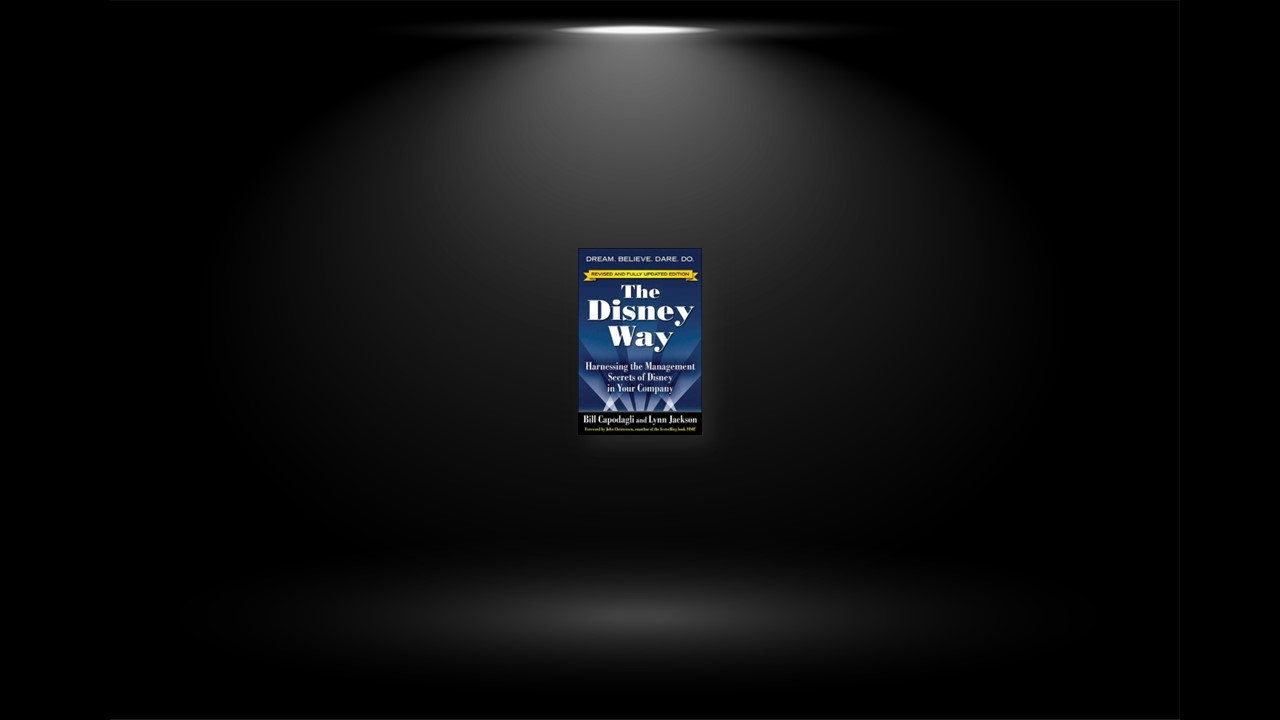Make Everyone’s Dreams Come True
It is no easy matter to convey a dream. Dreams are, by nature, deeply personal experiences. But true to his imaginative genius, Walt Disney was able to transform his dreams into stories that effectively articulated his vision to others. More importantly, the stories served to draw others into his fantasies, thereby marshaling the power of their collective creativity for the benefit of his dream.
In the early days, when The Walt Disney Company was small, Walt used to call his five or six animators into his office to discuss an idea for a new film project. With dramatic effect, he would embark on a story—not a literal narrative account of his idea, but an ancient myth, perhaps, or some other related tale that conveyed the feelings and emotions behind his dream and his hope for the project’s success. In short order, the master would capture the imaginations of his “cast members” (“employees” in the usual corporate parlance) and in the process stimulate the kind of excitement and commitment of minds and hearts that he well knew was necessary to turn Disney-size dreams into reality. For example, he insisted that the castle at Disneyland be built first—before anything else—so that this visual structure could help shape the vision and rally everyone around the dream he was trying to create.
You Better Believe It
When Walt Disney was still an infant, his family moved from Chicago to a farm in Marceline, Missouri, about 100 miles east of Kansas City. Farm life is hard and demanding, and a growing boy, then as now, always has chores to do. But after the barn was mucked out or the apples picked, young Walt would lie in the grass and gaze up at the Missouri sky or watch insects and butterflies flit overhead. These were memories that he treasured all his life.
From those early years growing up in a rural environment, Disney formed beliefs and values that stuck with him throughout his life from which he never deviated. His love of nature, handsomely depicted in numerous animated and live action films, surely can be traced to those experiences, as can the basic foursquare family values that still guide The Walt Disney Company today.
Perfectly complementing Walt’s firmly held beliefs was the philosophy expressed by his brother, Roy: “When values are clear, decisions are easy.” Together, these precepts formed what is, in effect, The Walt Disney Company’s mantra: “Live your beliefs”—or what we simply call Believe.
Carrying that theme a step further, we might add that if “seeing is believing,” then the unparalleled success of The Walt Disney Company is convincing proof of the power inherent in the Believe principle. But as our clients know, before success can be achieved, a personal set of core values must be formalized, communicated to the company at large, and actually lived day to day. Disney has shown the way.
Never a Customer, Always a Guest
In an age when consumers all across the country bemoan the state of customer service, The Walt Disney Company is repeatedly hailed as a superior service provider, perhaps the best in the world. On the day Disneyland opened, Walt himself announced the theme park’s motto: “At Disneyland, the visitors are our guests.” Since then, the bar has continually been raised to new heights in the company’s desire to delight its guests.
That visitors should be treated as guests is also a theme that emerges in nearly every movie Walt Disney made. The dwarfs welcome Snow White into their cottage; forest animals care for Bambi after his mother dies; the Banks family invite Mary Poppins into their home; and, of course, “Be Our Guest” is the title of one of the best-known songs from the 1991 film Beauty and the Beast. The guest motif is present in every corner of Disney, from the Magic Kingdom to Animal Kingdom.
Walt Disney knew instinctively what his visitors wanted. He didn’t need to do expensive research into customer tastes because, as he once put it, his audience was “made up of my neighbors, people I know and meet everyday: folks I trade with, go to church with, vote with, compete in business with, help build and preserve a nation with.”
Disney’s understanding of his customer base coupled with his innate drive for perfection meant that audiences got more than they ever knew they wanted, whether in watching his films or visiting his theme park.
Dare to Dare
Premier players can be found in all corners of the business world, and one thing they have in common is a willingness to take bold risks. They clearly understand that grasping at a dream requires one to reach beyond the sure thing. Even more, they seem to relish the opportunity. Walt Disney was just such a player.
In fact, if there literally were a cornerstone upon which The Walt Disney Company rested, it would have to be inscribed with one short word: Dare. Throughout the 43 years that Walt ran the company, he dared to meet challenges; he dared to take risks; and, ultimately, he dared to excel.
From the time that he decided to produce his first cartoon, Disney pushed the limits of ordinary achievement. He pioneered the use of sound in animated cartoons with Steamboat Willie. He signed his contract with Technicolor before the revolutionary process had even been accepted by the industry as a whole and astutely insisted on a two-year exclusive for his cartoons. He originated feature-length cartoons with Snow White and defied the odds at a time when no one thought anyone would ever sit through a 90-minute cartoon.
Even Walt’s decision to build Disneyland represented a new and risky concept in entertainment. Up to that time, amusement parks had something of an unsavory connotation, an association with the tawdriness of pre-1950s carnivals. It took the vision of Walt Disney to imagine a place that would incorporate historical reconstructions, displays, and rides, and it took the daring of Walt Disney to build it into a world-famous tourist attraction.
The Disney experience illustrates how a company willing to take calculated risks can advance the level of development of a product or service and, in the process, reap huge rewards. But not all corporate executives and managers fall into this enviable category. Too many opt for the safest route because they fear failure or loss. They allow themselves to get bogged down in corporate bureaucracy, which can keep the management process from flowing as it should.
Practice, Practice, Practice
Actors, musicians, athletes, and others who perform in public must train and practice. Otherwise, they risk embarrassing themselves and incurring the displeasure of spectators. Of great importance, too, is the teacher or coach who tells the musician that he or she is hitting the wrong notes or advises the athlete about batting stance, running form, and so on. Without such helpful criticism and the benefit of the more experienced mentor’s knowledge, a performer’s career is likely to be short-lived.
So it is in business. To perform at their best, a company’s employees must be thoroughly trained, and they need the help of more experienced staff members. Moreover, to maintain their competencies, training can’t be a one-shot thing; it must be ongoing.
The students of Disney University enjoy the most exciting campus of any educational institution in the country: Over 29,000 acres of Disneyland and Walt Disney World and anywhere else the company operates. The required course work is brief, but it’s famous for its intensity. The freshmen are all new members of the Disney family: Some are there to prepare for a summer job; others are being readied to assume a permanent position.
Disney University—a process, not an institution—was conceived by Walt Disney himself prior to the opening of Disneyland in the 1950s. Today, every new employee, from senior executives to part-time desk clerks and tour guides, is required to undergo training prior to embarking on her or his day-to-day responsibilities. And in typical Disney fashion, the training process leaves nothing to chance, not only imparting knowledge about specific job skills and competencies, but also, and perhaps more important, ensuring that every employee has a thorough understanding of the Disney culture and traditions.
Thus, what is euphemistically called “human resources” at many organizations—which view training as no more than an expensive but sometimes necessary evil—is given top priority in the Disney universe. That’s because Walt considered training an essential investment in the future of his company.
Give Details Top Billing
Business people of every stripe place a great deal of importance on seeing the “big picture” or coming up with the grand idea. But seldom understood is the fact that details give the big picture depth; they bring the grand idea clearly into focus and produce pride in workers’ skills. Paying attention to the little things is what turns the vision into a top-quality product or an outstanding service. As the great architect Mies van der Rohe once put it, “God is in the details.”
No one had to tell Walt Disney the significance that seeming trifles can have when excellence is the goal. Perhaps because he possessed an artist’s eye, he recognized that attention to detail was the key to complete realization of his dreams. As a result, the company he founded has no equal when it comes to creating the thousands of intricate drawings needed to produce nonpareil animation, bring together the mind-boggling number of parts required to build a Disneyland or a Walt Disney World, or carefully attend to the numerous small details that make every guest’s experience a magical one.
Often overlooked in Disney’s awe-inspiring success is how the company as an organization has managed to give extravagant attention to detail without bankrupting itself. It has achieved a careful balance between the competing demands of the bottom line and the quest for perfection. The key to this balancing act is contained in the Disney philosophy that everyone—from the groundskeepers at the parks and the animators in the movie studio to the number crunchers in the accounting department—is responsible for doing whatever it takes to deliver the “good show.” Even Bob Iger has “trash collecting” in his job description when he’s visiting one of the theme parks! When all parties are convinced of the importance of their individual roles, nothing will be left to chance.
Most of the companies we work with are far removed from the Disney environment of entertainment, yet they too have recognized that obsessive attention to detail can pay huge dividends. Thus, they are calling on “casts” of employees to present their own version of the good show to an “audience” composed of suppliers and customers, and in doing so, these companies are consistently delivering quality products and services to their target markets.


